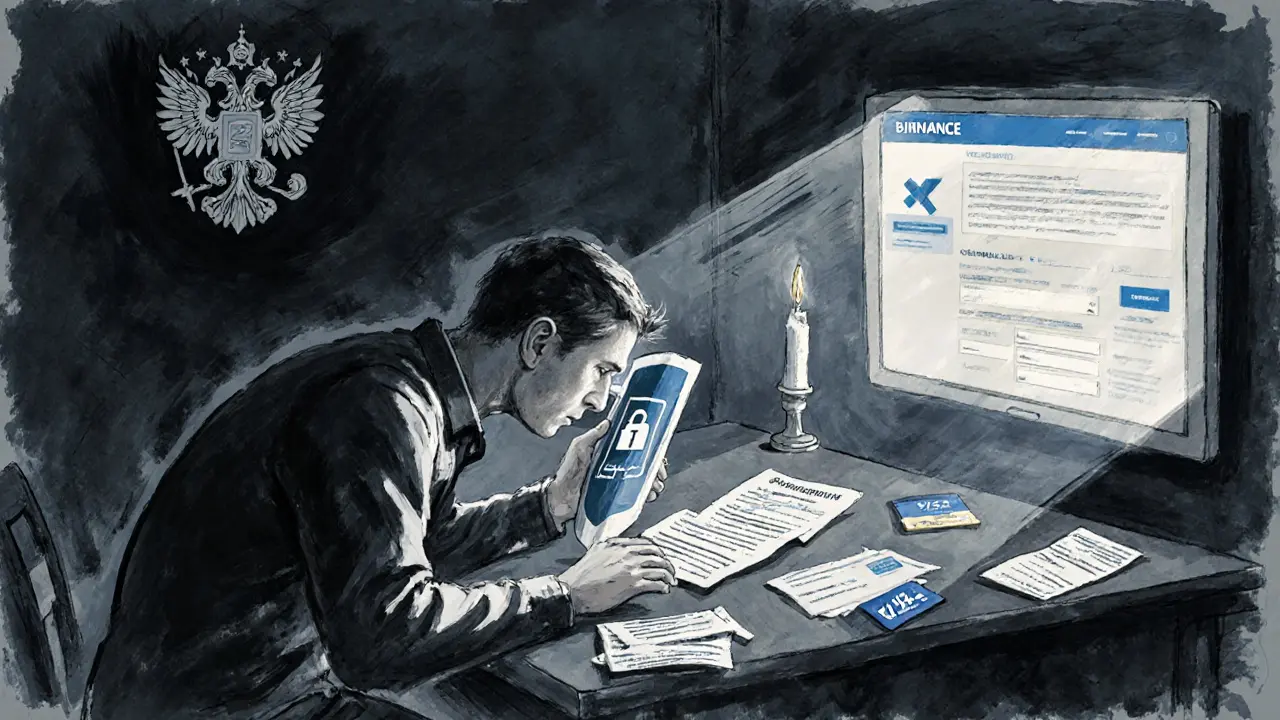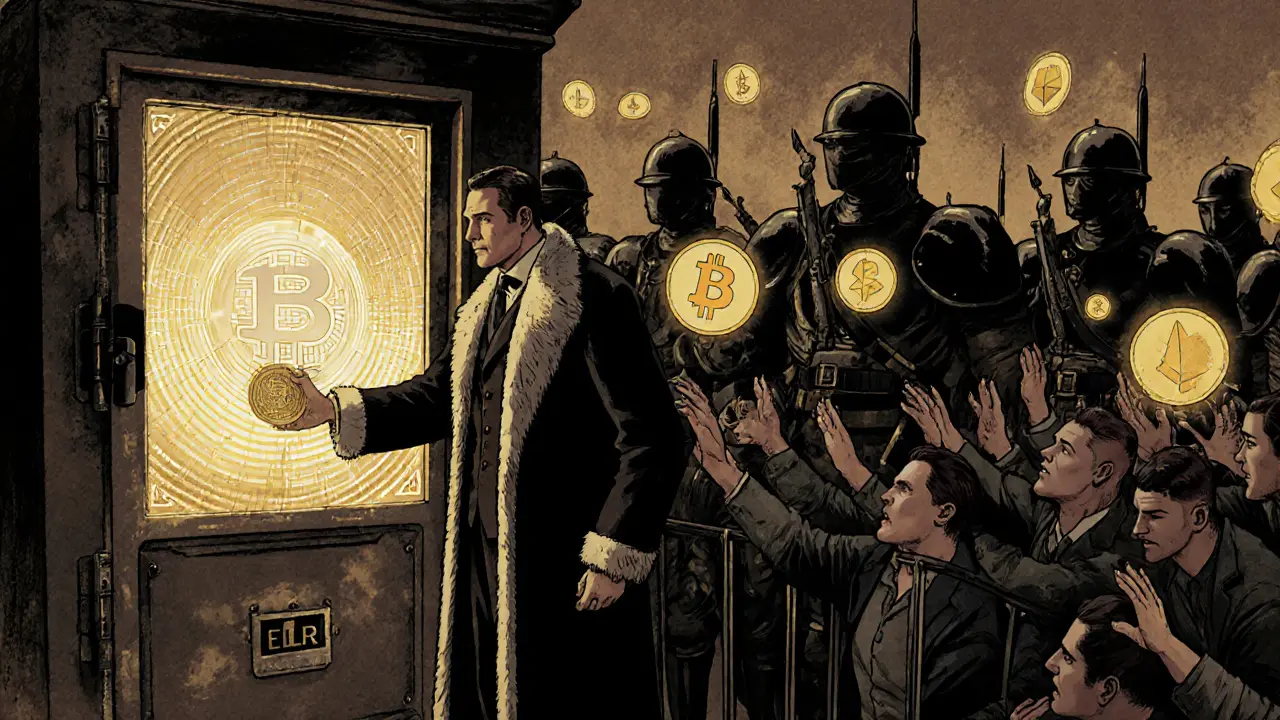Russian Crypto Investor Eligibility Calculator
Determine if you qualify as a 'qualified investor' under Russian regulations to legally trade cryptocurrency. To qualify, you must meet one of these thresholds:
- Annual income of 50 million rubles (≈ $550,000 USD)
- Investment portfolio of 100 million rubles (≈ $1.1 million USD)
By 2025, Russian citizens face some of the strictest crypto restrictions in the world. While owning Bitcoin or Ethereum isn’t technically illegal, actually buying, selling, or using crypto through normal channels is nearly impossible for most people. The government hasn’t banned crypto outright-it’s built a system that lets the wealthy and connected trade, while locking everyone else out.
What’s Actually Allowed?
The Russian government legalized cryptocurrency in 2020, but with a catch: you can’t use it to pay for groceries, rent, or services inside Russia. That rule kicked in in January 2021. So crypto isn’t money-it’s more like a digital collectible you can hold but not spend.
In 2023, the state created a special loophole called the Experimental Legal Regime (ELR). This lets a handful of approved companies use crypto for international trade. Think arms dealers, sanctioned oil exporters, or state-linked firms buying foreign tech. These companies can move crypto across borders without triggering sanctions. But ordinary Russians? They’re not on the list.
Who Gets to Trade Crypto Legally?
If you’re not part of the elite, you’re blocked. The Central Bank of Russia says only highly qualified investors can legally trade crypto. To qualify, you need either:
- An investment portfolio worth at least 100 million rubles (around $1.1 million USD)
- Or an annual income over 50 million rubles (about $550,000 USD)
That’s less than 0.1% of the population. Most Russians earn under 1 million rubles a year. So unless you’re a billionaire or connected to the state, you’re legally excluded.
Even if you somehow meet the income threshold, banks won’t help you. The Central Bank forbids Russian financial institutions from offering crypto services to retail customers. No crypto wallets through Sberbank. No trading platforms linked to your Visa card. No crypto ATMs. The banking system is designed to cut you off.
What Happens If You Try Anyway?
Many Russians still try. They use VPNs to access Binance, Coinbase, or Kraken. But these platforms aren’t playing nice. Since 2022, major exchanges have frozen over 25,000 Russian accounts due to sanctions compliance. Coinbase’s rating from Russian users sits at 2.1 out of 5 on Trustpilot, mostly because accounts vanish without warning.
Binance still lets some users trade, but only if they pass heavy KYC checks-like uploading a foreign passport or proof of address from another country. That’s impossible for most. A September 2025 survey of 1,200 Russian crypto users found 68% failed identity verification attempts.
And if you’re trading small amounts through P2P platforms like LocalBitcoins or Paxful? The Central Bank has warned that frequent small trades can get your bank account blocked. That’s right-using crypto to send money to a friend in Turkey could get your savings frozen.

Why Is Russia Doing This?
It’s not about protecting citizens from scams. It’s about control.
After Western sanctions cut Russia off from SWIFT and global banking, the government needed a way to move money abroad without triggering alarms. So they created a legal backdoor for sanctioned entities to use crypto. Meanwhile, they scared ordinary people away from crypto by making it risky, confusing, and legally dangerous.
It’s a two-tier system: one for the powerful, one for everyone else. The goal? Keep rubles circulating domestically. Prevent capital flight. Stop people from using crypto to bypass the state’s control over money.
It’s working-sort of. Russian crypto trading volume has dropped 83% since early 2022. But that doesn’t mean people stopped using crypto. It just means they moved underground.
How Are Russians Getting Crypto Now?
Most Russians who still want crypto rely on three things:
- VPNs to access offshore exchanges
- P2P trading with strangers who accept cash, bank transfers, or even gift cards
- Friends abroad who buy crypto for them and send it via wallet
But P2P is risky. There’s no protection. Scams are common. And if you trade too often, your bank notices. A 2025 report showed 79% of Russian users struggle to cash out crypto into rubles. No exchange will let you convert your Bitcoin into cash without jumping through impossible hoops.
Some turn to decentralized finance (DeFi) platforms like Uniswap or PancakeSwap. These don’t require KYC. But they’re technical. You need to understand wallets, gas fees, and private keys. For most people, it’s too hard.

What’s the Real Impact?
Russia has an estimated 17.7 million crypto owners-the 8th highest in the world. But almost none of them use legal channels. Over 87% of all crypto transactions in Russia happen outside regulated systems.
The result? A thriving black market. A growing gap between the rich and everyone else. And a financial system that’s more isolated than ever.
Even experts admit the policy is failing. The Bitcoin Policy Institute says Bitcoin won’t save Russia from sanctions-because big exchanges won’t let large sums move undetected. Norton Rose Fulbright confirms blockchain analytics firms track Russian crypto flows in real time. The government’s attempt to control the system is being outsmarted by technology.
Is There Any Hope for Change?
In October 2025, the Central Bank hinted at a small shift: banks might be allowed to offer crypto services-but only if crypto makes up less than 1% of their total business. That’s not a reopening. It’s a tiny crack.
There’s talk of lowering the income threshold for qualified investors. But no official changes have been made. And even if they did, the gap between the elite and the rest would still be massive.
The future looks like this: for most Russians, crypto remains a risky, underground activity. For the top 0.1%, it’s a sanctioned tool for global trade. Everyone else is stuck in the middle-watching, waiting, and hoping for a way out.
What Should You Do If You’re a Russian Citizen?
If you’re trying to access crypto:
- Don’t trust any platform claiming to be a “Russian crypto exchange.” There are none that are legal.
- Use a reputable VPN. Free ones often log your data.
- Never send large amounts through P2P without a trusted middleman.
- Keep your private keys offline. If your account gets frozen, you’ll need them to recover your assets.
- Understand that your bank might monitor your transactions. Avoid frequent small transfers.
There’s no safe, easy path. The system is designed to make it hard. Your best bet is to learn, stay cautious, and accept that crypto in Russia is no longer a financial tool-it’s a survival tactic.
Is it legal to own Bitcoin in Russia in 2025?
Yes, owning Bitcoin or other cryptocurrencies is legal in Russia. However, using them to pay for goods or services domestically is banned. You can hold crypto as an asset, but you can’t spend it like money inside Russia.
Can Russian citizens use Binance or Coinbase?
Technically yes, but with severe restrictions. Binance requires Russian users to complete strict KYC, including proof of address from outside Russia. Coinbase has frozen over 25,000 Russian accounts since 2022. Most users report account freezes, limited services, and difficulty withdrawing funds.
Why are Russian bank accounts getting blocked for crypto trading?
The Central Bank of Russia warns that frequent small-scale peer-to-peer (P2P) crypto trades can trigger anti-money laundering flags. Banks are required to monitor and block accounts showing patterns linked to crypto activity, even if the transactions are legal under Russian law.
Can Russians use crypto to bypass Western sanctions?
Not effectively. While the Russian government allows sanctioned entities to use crypto for international trade, major global exchanges like Binance and Coinbase comply with Western sanctions. Large-scale laundering through crypto is expensive, slow, and easily tracked by blockchain analytics firms. Bitcoin won’t save Russia from sanctions.
What’s the difference between the ELR and regular crypto trading?
The Experimental Legal Regime (ELR) is a government-approved system that lets only vetted companies use crypto for foreign trade. Regular Russian citizens are excluded. ELR trades are monitored, reported, and limited to specific industries. It’s not a path for individuals-it’s a tool for sanctioned businesses.
Are there any Russian crypto exchanges?
No. There are no legal, domestic crypto exchanges operating in Russia that serve ordinary citizens. All major platforms are offshore, and even those are heavily restricted for Russian users. Any platform claiming to be a Russian exchange is either a scam or operating illegally.
How many Russians still use crypto despite the restrictions?
An estimated 17.7 million Russians still own cryptocurrency, according to Chainalysis 2025. However, over 87% of their transactions happen outside regulated channels-through P2P trading, DeFi platforms, or offshore exchanges using VPNs.

Chloe Jobson
October 29, 2025 AT 01:26This is such a clear example of financial apartheid. The state creates a legal backdoor for elites while criminalizing survival for everyone else. It’s not about sanctions-it’s about control. And the fact that 17.7 million Russians still hold crypto? That’s resistance in code.
Blockchain doesn’t care about borders. It only cares about keys.
They can ban exchanges, freeze accounts, and scare banks-but they can’t unlearn decentralization.
Akinyemi Akindele Winner
October 29, 2025 AT 08:58Man, Russia ain’t banning crypto-they just made it a VIP club where only oligarchs get the golden ticket. Meanwhile, the rest of us are out here trading Bitcoin for potatoes via Telegram like it’s 2012.
It’s not illegal to own crypto-it’s illegal to be poor and own crypto. That’s the whole damn joke.
Patrick De Leon
October 30, 2025 AT 11:27Let’s be honest-this is the only sane response to Western sanctions. If you let ordinary people move money freely, the whole ruble collapses overnight. The elite need to trade. The masses need to be contained. It’s not cruel-it’s economic realism.
Stop crying about freedom. This is war.
And crypto? It’s a weapon. Not a right.
MANGESH NEEL
November 1, 2025 AT 08:45Oh wow, so the poor are being punished for daring to want financial freedom? How DARE they try to escape the state’s iron grip? How DARE they not want to be trapped in a ruble hellhole?
And now we’re supposed to feel bad for the billionaires who get to use crypto? Please. This isn’t policy-it’s moral bankruptcy wrapped in a Central Bank press release.
Meanwhile, 87% of crypto trades happen underground. That’s not failure-that’s a revolution in slow motion. The state is losing. And they know it.
Sean Huang
November 1, 2025 AT 22:34Think about it… what if this isn’t about control at all? What if the real goal is to create a digital divide so deep that only those with foreign passports and offshore assets can survive?
And what if the Central Bank is secretly working with blockchain analytics firms to track EVERY transaction… so they know who to target next?
They’re not just banning crypto… they’re mapping dissent. This is the new surveillance state. And we’re all just lab rats in a global experiment.
They’ll come for your keys next.
Are you ready?
Ali Korkor
November 2, 2025 AT 11:59You got this. I know it feels impossible right now, but people are still finding ways. VPNs, P2P, friends abroad-none of it’s perfect, but it’s working.
Keep your keys safe. Learn one thing a week. You don’t need to be a tech wizard-just careful.
You’re not alone. Millions are in the same boat. And one day, this wall will crack.
Stay strong.
madhu belavadi
November 3, 2025 AT 13:06Why do you even care? You’re not even Russian. You’re just here to feel morally superior. I’ve seen this before. You love watching people suffer from afar.
Go post something about your cat instead.
Dick Lane
November 5, 2025 AT 07:51I’ve been watching this play out for years. What’s wild is how predictable it all is.
The state doesn’t want people to leave the ruble system. So they make crypto feel like a trap. Scary. Unreliable. Risky.
But the people? They’re not stupid. They know what’s happening.
And they’re still moving money.
That’s the quiet rebellion.
Norman Woo
November 6, 2025 AT 07:42so like… if the gov can track crypto flows… why are they even letting it exist?
is this all just a trap? like… they let you use it so they can see who’s doing it… then freeze your bank account later?
or is it… that they actually think they can control it?
either way… its messed up
and why is no one talking about how de-fi is the real escape hatch?
no kyc… no bank… just code
but like… if you mess up your seed phrase… you’re done
Serena Dean
November 7, 2025 AT 15:42Hey-just wanted to say, if you’re trying to access crypto right now, you’re already braver than most.
Don’t let the fear win. Use a trusted VPN. Stick to well-known P2P platforms. Always verify the person you’re trading with. And for heaven’s sake, keep your private keys offline.
There’s no perfect solution-but you’re not alone. There are forums, Telegram groups, even Reddit threads where people share safe tips.
You’re not breaking the law by trying to survive. You’re just playing the game they rigged.
And you’re not losing.
You’re learning.
James Young
November 8, 2025 AT 03:14Everyone’s acting like this is some kind of injustice. It’s not. It’s economics 101. When your currency is collapsing and your country is under sanctions, you don’t let peasants gamble with digital assets. You protect the system.
Letting 17 million people trade crypto freely would destroy the ruble in weeks.
So yes, it’s oppressive. But it’s also necessary.
Stop romanticizing crypto. It’s not freedom-it’s financial chaos waiting to happen.
Andrew Morgan
November 9, 2025 AT 03:08There’s something poetic about this.
They built a wall around money.
And people are climbing it with code.
Not with protests.
Not with petitions.
With wallets.
With private keys.
With trustless networks that don’t care who you are.
The state thought it was controlling the future.
Turns out-it just gave people the tools to build a new one.
And that’s the scariest part.
Michael Folorunsho
November 10, 2025 AT 13:22Let’s cut through the noise. This isn’t about ‘freedom’ or ‘human rights.’ It’s about power. The Russian elite need to move capital. The masses need to be kept docile. Crypto is the perfect tool for that.
And anyone who thinks this is ‘unfair’ is either naive or a Western propagandist.
Stop projecting your liberal ideals onto a sovereign state trying to survive an economic war.
It’s not cruel. It’s survival.
And if you can’t handle that reality, then you don’t belong in this conversation.
Roxanne Maxwell
November 12, 2025 AT 06:15I’ve worked with Russian developers for years. They’re some of the smartest, most resilient people I know.
This policy isn’t just hurting them financially-it’s hurting their dignity.
They’re not criminals. They’re engineers, teachers, doctors-trying to protect their savings.
And yet, they’re treated like suspects.
I just hope someone in power sees that one day.
Not because of pressure.
But because it’s the right thing to do.
Jonathan Tanguay
November 12, 2025 AT 09:10Let me break this down for you since you clearly didn’t read the full article. The ELR is not a loophole-it’s a sanctioned backdoor for oligarchs and arms dealers. The Central Bank doesn’t care about retail users because they’re irrelevant to the state’s agenda. The 100 million ruble threshold isn’t a mistake-it’s a feature. It’s designed to exclude. And the fact that 87% of trades happen off-exchange proves the system is already failing. The government’s entire strategy is based on the assumption that ordinary people are too stupid to use DeFi. But they’re not. They’re just scared. And that fear is being weaponized. The real tragedy isn’t the bans-it’s that the state thinks it can outsmart blockchain. It can’t. Decentralization doesn’t negotiate. It just exists. And one day, when enough people have private keys and no one can take them away, this entire structure will collapse under its own hypocrisy. You can’t control what you can’t see. And crypto? It’s invisible until it’s too late.
Ayanda Ndoni
November 12, 2025 AT 16:54Wait so… you’re saying Russians can’t buy crypto but can still use VPNs? That’s it? That’s the whole problem? I mean… couldn’t they just… get a friend abroad to buy it for them?
why is this even a thing? i dont get it
also i just want to know if you guys are okay
like… really
are you eating?
are you sleeping?
Elliott Algarin
November 13, 2025 AT 04:49There’s a quiet dignity in this resistance.
People aren’t rioting.
They’re not screaming.
They’re just… keeping their keys.
One transaction at a time.
One wallet at a time.
One friend who trusts them enough to send them a little Bitcoin.
It’s not loud.
But it’s real.
And maybe… that’s the most powerful kind of revolution.
John Murphy
November 14, 2025 AT 07:41I’m curious how many of these 17.7 million people actually know how to use a hardware wallet
or if they’re just storing keys on their phones
or worse-on cloud drives
because if they are… then the real crisis isn’t the ban
it’s the lack of education
and that’s something no government can fix
only time and community can
Zach Crandall
November 15, 2025 AT 06:04The irony is that Russia’s crypto policy is the most transparent example of state capitalism in the modern era.
They’ve turned digital assets into a tool of exclusion.
Not to protect the people.
But to protect the power structure.
And in doing so, they’ve created the perfect case study for why decentralization matters.
Because when the state controls money…
it controls life.
And that’s why crypto isn’t just technology.
It’s liberation.
Ali Korkor
November 16, 2025 AT 04:20Thank you for saying that. I’ve been trying to explain this to my cousin in Moscow. She’s scared. But she’s still using P2P. She says it’s the only way to send money to her sister in Georgia.
You’re right-it’s not about freedom.
It’s about family.